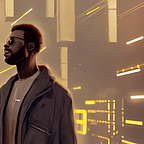The Struggle Is Real: Why AI Models Have a Hard Time Drawing Eyes
Exploring the peculiar challenge of rendering eyes in AI-generated images
AI-generated images have come a long way in recent years, with impressive advancements in neural networks and deep learning. However, despite these advancements, AI models often struggle to create realistic and natural-looking eyes in the images they generate.
In this article, we’ll explore the reasons behind this phenomenon and examine why eyes tend to look “weird” in AI-generated images.
- Complexity of the human eye:
The human eye is a remarkably complex and intricate structure, consisting of multiple layers, tissues, and nerves. The eyes are not only essential for vision, but they also play a crucial role in non-verbal communication and emotional expression. Consequently, capturing the subtle nuances and details of the human eye is a considerable challenge for AI models.
2. Limited training data:
One key reason why AI models struggle to render eyes accurately is the limited availability of high-quality training data. For AI models to learn to generate realistic images, they require vast amounts of training data, including images of eyes in various positions, lighting conditions, and emotional states. Unfortunately, the available data sets often lack the diversity and quality needed for AI models to learn the subtleties of human eyes.
3. Difficulty in capturing emotion:
Eyes are the windows to the soul, and they play a significant role in conveying emotions. AI models have a hard time understanding and replicating the intricate emotional cues that are often present in human eyes. This challenge can be attributed to the models’ inability to fully grasp human emotions and the subtle interplay of facial muscles that control the appearance of the eyes.
A great book on AI is Life 3.0: Being Human in the Age of Artificial Intelligence , which gives a incredible perspective.
4. Overfitting and underfitting:
AI models can suffer from overfitting, where they become too specialized in their training data and struggle to generalize to new examples. On the other hand, underfitting occurs when a model is too simplistic and fails to capture the complexity of the data. Both of these issues can lead to unnatural-looking eyes in AI-generated images, as the models struggle to adapt to the myriad variations and details present in human eyes.
5. Ethical concerns and limitations:
Another factor contributing to the AI models’ struggle with rendering eyes is the ethical concerns surrounding facial recognition and privacy. As a result, many training datasets are intentionally limited or obfuscated to prevent misuse. These limitations can hinder the ability of AI models to learn the nuances and details of human eyes accurately.
For further reading on AI checkout out these books and articles:
AI 2041: Ten Visions for Our Future
Robot-Proof: Higher Education in the Age of Artificial Intelligence (The MIT Press)
Conclusion:
While AI-generated images have come a long way, the struggle to create realistic and natural-looking eyes remains a significant challenge.
The complexity of the human eye, limited training data, difficulty in capturing emotion, and ethical concerns all contribute to the “weird” appearance of eyes in AI-generated images. As AI models continue to evolve and improve, we can hope to see more accurate and lifelike eyes in the future.
👋🏿 If you liked this article and want to support you can Buy Me a Coffee 😊☕️
However, this progress must be balanced with ethical considerations to ensure the responsible development and deployment of AI-generated imagery.
I’m an affiliate for Amazon and there are affiliate links in this post. That means if you make a purchase after clicking on one, I may make a commission.
